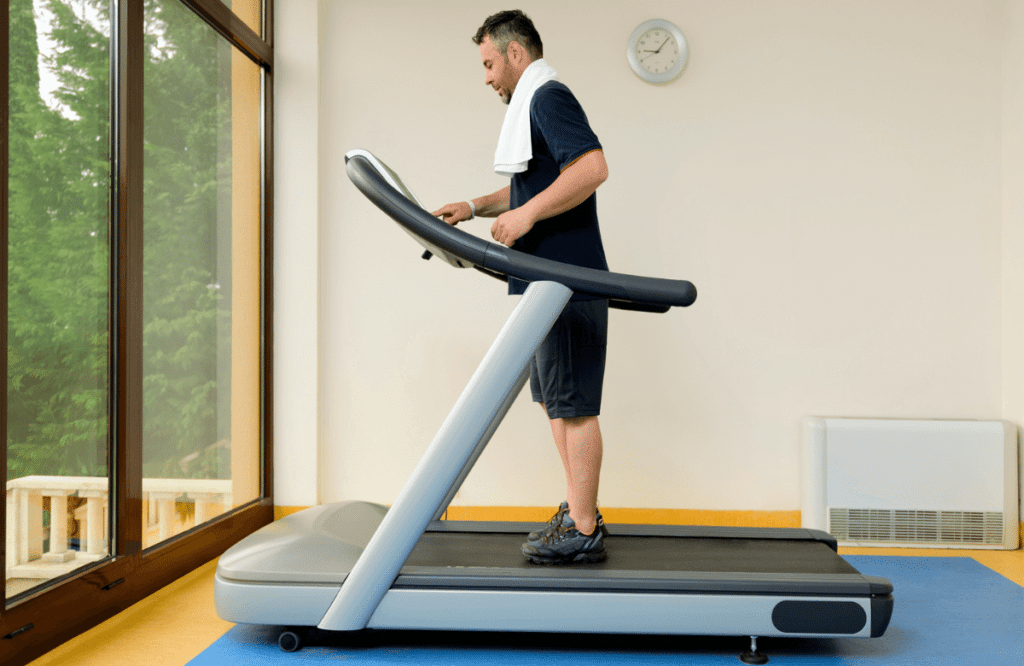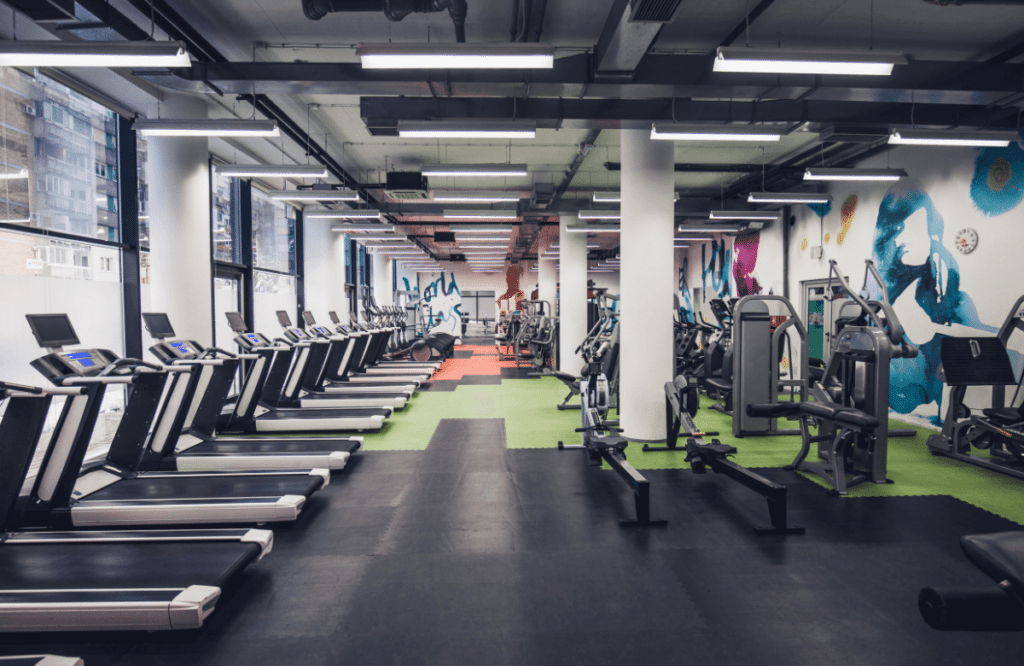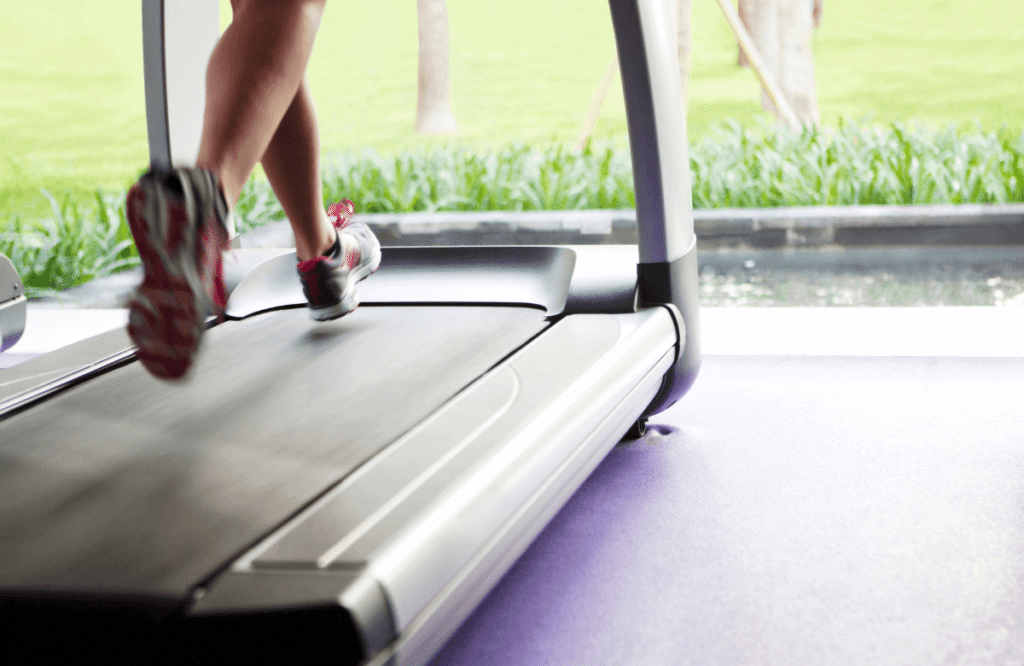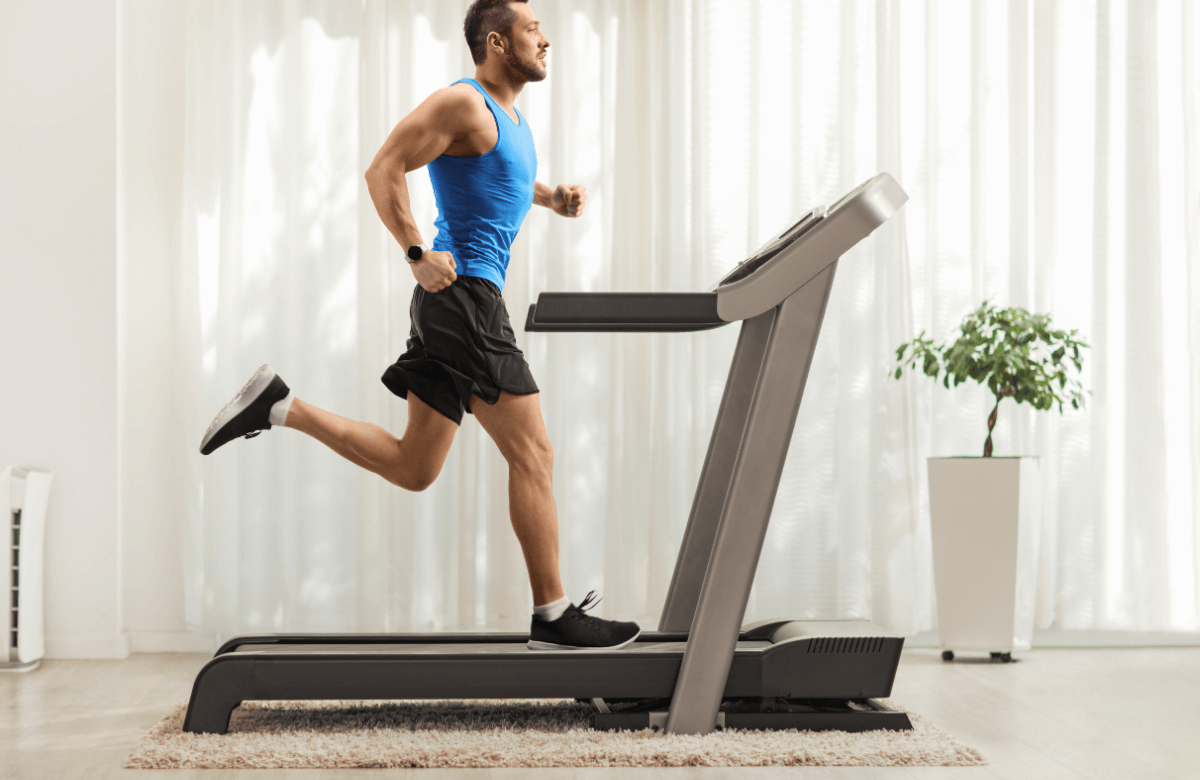When getting a treadmill for your home or apartment, choosing where to put it is an important detail. Treadmills aren’t easy to move, and putting one in the wrong place could cause damage to your floors or even the machine.
This brings us to a common question about treadmills as part of your home gym: Can you put a treadmill on carpet? Let’s consider the facts.
Jump to:
- Can You Place Your Treadmill on a Carpet?
- When You Shouldn’t Use a Treadmill on Carpet
- How to Effectively Use a Treadmill on Carpet
- Why You Need a Treadmill Mat Regardless
- What to Consider When Buying a Treadmill Mat
- Which Is Better for a Treadmill: Hardwood Floor or Carpet?
- Are There Good Alternatives to Treadmill Mats?
- FAQs
Can You Place Your Treadmill on a Carpet?
Yes, you can place a treadmill on a carpet, but it’s not always ideal. If you have low-pile or tufted carpets, you’ll have no problem putting your treadmill on top of it. The thin carpet makes a nice buffer between the subfloor and your treadmill with little fear of damaging it. In fact, you’ll often see treadmills on tufted carpet at gyms.
However, if you have a high pile carpet, you might be more concerned about it being damaged or about it damaging your machine. Usually, placing a treadmill mat as a protective layer between your carpet and the treadmill will suffice.
When You Shouldn’t Use a Treadmill on Carpet
If you have an extremely heavy treadmill, like one you might see in commercial settings, you might not want it on your carpet. The weight could damage the fibers and the padding below. If you ever move your treadmill, there may be permanent indentations from your machine.
You might also be concerned about carpet dust and fibers damaging your machine. Carpets, particularly high pile varieties, are magnets for dust and small bits of debris. The motion and vibrations of your treadmill can kick dirt and fibers into the gears of your treadmill. Without proper maintenance, you could shorten the lifespan of your machine.

How to Effectively Use a Treadmill on Carpet
If you’re putting a treadmill on carpet, there are a few things to keep in mind. Taking a few preventative measures can help to prevent serious damage to your flooring and machine.
Always Have a Mat Underneath
Placing a heavy duty mat under your treadmill is the very best thing you can do to protect your carpet from the weight and movement of a home treadmill. While a mat adds additional cost to your home gym, it’s worth every penny.
A mat protects the flooring beneath your treadmill by absorbing vibrations and movement so that it doesn’t dent or scratch your floors. A mat is a great way to keep a treadmill’s feet from ripping out carpet fibers. It will also prevent carpet fibers from getting caught in the belt or gears.
Keep Up with Treadmill Maintenance
Because your treadmill is on the carpet, it will be more susceptible to dust accumulation, debris, carpet fibers, etc. These can be kicked up into the belt or gears of the treadmill, causing it to jam or shortening the lifespan of your machine.
Keep your treadmill clean, using a damp cloth to wipe it down at least weekly to prevent dust build-up. Every month, you’ll want to clean under the belt and around the motor to remove any fibers that might have lodged inside. Oil, tighten, and adjust the belt as needed.
Look beneath the treadmill deck to check for dust gathering around your gears and the motor. Some areas of a treadmill can create dust reservoirs of sorts that can damage the gears if not cleaned.
These simple maintenance steps can keep the dust at bay and extend the life of your treadmill.
Consider Layering with Rugs
If you’re not using a treadmill mat, using a low-pile rug helps protect the carpet beneath. If you’re worried about the weight of the machine causing dents or damage in your carpet or padding, add multiple rugs for better padding.
Keep Your Surrounding Carpets Clean
Vacuum around your treadmill regularly to keep a combination of dust and debris from attacking your machine. Use a dustbuster on the room and your treadmill regularly. Consider having your carpets cleaned every few months as well.

Why You Need a Treadmill Mat Regardless
Whether you’re placing your treadmill on carpet or on wooden floors, you’ll want a treadmill mat. It’s the best protection available for both your flooring and your machine. It’s a non-slip surface that offers noise reduction and protection.
Your machine vibrates and moves as you use it, which will scratch and dent your flooring. It could even pull fibers out of your carpet. The treadmill mat will absorb the vibrations and movement, offering sufficient padding and protection so you can use your treadmill without worry.
The treadmill mat offers another purpose: It helps isolate any noise that the treadmill makes when it runs. If you live in a small house or apartment, or you’re on an upper level in an apartment building, the noise cancellation will be essential.
What to Consider When Buying a Treadmill Mat
Don’t take the protection of your flooring lightly. Buying the wrong treadmill mat could mean damaging your carpet or other types of flooring. We want to help you choose a decent treadmill mat. Here’s what to consider.
Thickness and Size
This may be the most important consideration to make. A mat that’s too thin and small won’t do much good against a heavy piece of equipment on your flooring.
Start by measuring the base of your treadmill. You’ll want about 6 inches of clearance around the perimeter of your treadmill to ensure that it doesn’t shift off the mat while you’re using it. While it’s not necessary, many people like having 2-4 feet at the foot of the treadmill so you have a non-slip surface to step on when climbing on and off the treadmill.
You might opt for mat squares that go beneath the four feet of your treadmill rather than an entire mat. If so, ensure that there’s several inches of clearance around each foot to prevent it sliding off the mats while in use.
Treadmill mats usually range from 0.25 in to 0.75 in thick. In many instances, 0.25 inches is plenty for protecting your flooring. This is particularly true if you’re putting it over carpet or concrete.
However, if you’re using a very heavy treadmill or you’re placing your treadmill on flooring you don’t want to scratch or dent, you might want to go for a 0.5-0.75 inch mat that offers additional protection.
If for any reason you wanted a thicker mat, you could use more than one mat.
Durability and Quality
Treadmill mats are usually made from PVC, foam, or rubber. High-density rubber mats are very popular because they’re water-resistant, flexible, durable, and offer strong protection between your treadmill and floor. They’re typically more expensive, but worth the money. And you can always choose recycled rubber if you’re looking for a more eco-friendly option.
PVC mats are also popular for their sturdiness and the fact that they’re waterproof. However, they’re less flexible and therefore don’t last as long. Still, heavy-density PVC foam can get the job done.
Foam is the most affordable but least popular style of mat because it’s very soft and susceptible to water damage. Heavy exercise equipment like a treadmill could wear right through a cheap foam mat. But there are many high-density foam mats that are more durable than a simple foam underlay.

Budget
Keep your budget in mind when shopping for mats. While thick high-density rubber mats are ideal, they may not be within your budget. Consider a thinner mat or one that’s made of PVC rather than rubber if you need to cut costs.
EVA is another option that’s very similar to rubber but often with a cheaper price tag. You can also buy high-density EVA foam that mimics some of the effects of rubber.
Noise Absorption
Depending on where you’re placing your treadmill, noise absorption may be a factor. If you’re in an upstairs room or in an apartment, you’ll want a mat that will help dampen the noise level of your treadmill.
The best product for noise absorption is high-density rubber or EVA. If you’re getting noise complaints about your treadmill, it might be worth springing for the higher-quality mat.
Ease of Cleaning
To keep your treadmill in good condition, you’ll want to clean the mat regularly. Once again, rubber is among the best options in this category. It’s easy to clean and helps to keep dust and debris from falling beneath the mat as well.
Foam is likely the most difficult to clean, as it’s more absorbent than other materials.
Stability
You need a mat to offer a stable base and keep your treadmill in place through all the vibrations and movement as you use your treadmill daily. High-density rubber will be ideal for this and foam will likely be the most slippery. Some PVCc products could also be slippery. Read reviews on a product you’re considering to know whether or not it will keep your treadmill in place.
Which Is Better for a Treadmill: Hardwood Floor or Carpet?
For many people, hardwood flooring may seem like a logical alternative to carpet for the flooring beneath your treadmill. However, this is usually a worse alternative to carpet if you want to preserve your flooring. The vibrations and heaviness of the machine will likely cause deep scratches and dents.
The same goes for laminate or luxury vinyl floors. These are softer floors that will sustain more damage if you’re placing heavy equipment on top.
So carpet may be the better option if your other options are hardwood, laminate, or luxury vinyl floors. However, a high-quality treadmill mat or another thick padding may offer all the protection you need if you only have hard floor options.
Are There Good Alternatives to Treadmill Mats?
While a treadmill mat seems to be the best option for protecting your floors, some have used other things with success. Exercise mats, utility rugs, foam floor tiles, or even an office mat might make good temporary solutions while you find the right treadmill mat for you.
However, these makeshift items likely won’t be as long-lasting or effective as a treadmill mat. Eventually, you’ll want to bite the bullet and buy a dedicated treadmill mat to do the job properly.

FAQs
If you’ve thought of additional questions while reading this article, you’re not alone. Here are answers to the most commonly asked questions we see for this topic.
Where Can I Put a Treadmill in My House?
In reality, most living spaces in the house can be suitable for your treadmill. Living rooms, bedrooms, family rooms, garages, unfinished basements, office spaces, and attics all make great places to store and use your treadmill.
You’ll want to consider things like how much space you have, how much noise it makes, how easy it is to move, and how often you’ll use it. For example, if you live in an upstairs apartment, you’ll want to be careful about placing your treadmill somewhere that will make a lot of noise or make sure you buy a quality pad to absorb the noise.
If you’re tight on space, look into getting a space-saving foldable treadmill or an under-desk treadmill that’s designed for small spaces.
How Much Space Does a Treadmill Need?
The official recommendation is to have about 20 inches on the front and sides of your treadmill and about 40 inches behind. These measurements are considered safest in case you fall off. It also offers adequate airflow for your machine.
You’ll also want at least 8-foot ceilings for adequate head space. If you’re short and are the only one who will be using your treadmill, you could get away with 7 foot ceilings. Thankfully, most homes and apartments today are built with 8 foot ceilings at a minimum.
If you have other cardio equipment or fitness equipment, give your treadmill at least 1-2 feet in between for safety.
Is It Okay to Put a Treadmill on Concrete?
Yes, many people use concrete surfaces in their garages or basements to store their treadmills. It’s very unlikely that the treadmill will damage this type of flooring, and most people wouldn’t care if it did make small marks since concrete is already imperfect.
The biggest downside to putting a treadmill on concrete is the noise in some cases. Some areas with concrete floors can be echoey. It might also shift more than you like in this space. Therefore, we still recommend a treadmill mat.
Will a Treadmill Damage Hardwood?
Yes, a treadmill without a mat underneath will almost certainly damage hardwood floors. The wood is not designed to withstand the weight, impact, and vibrations of a treadmill, and it will scratch and dent your hardwood floors as a result.
As a general rule, always use a quality treadmill mat under your machine, and you won’t have to worry overly about damage to your flooring.














